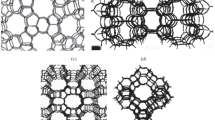Abstract
Conversions of cyclohexane and cyclohexane mixtures with 2-methylthiophene (5000 ppm S) and pyrrole (500 ppm N) over dual-zeolite cracking catalysts have been studied. The catalysts have been synthesized using zeolites Y in the HREE form and ZSM-5 modified with phosphorus. The effect of conditions (temperature in a range of 510–630°C, dilution ratio of the reaction medium with an inert gas up to 2 : 1 mol/mol) on the cracking product composition has been studied. It has been shown that an increase in temperature and the dilution ratio of the reaction medium contributes to an increase in the light olefin yield. The highest yield of C2–C4 olefins (40 wt %) has been achieved over a catalyst with an Y : ZSM-5 zeolite ratio of 1 : 3. The presence of sulfur and nitrogen compounds leads to a decrease in the feedstock conversion and an increase in the light olefin selectivity.




Similar content being viewed by others
REFERENCES
R. Sadeghbeigi, Fluid Catalytic Cracking Handbook: An Expert Guide to the Practical Operation, Design, and Optimization of FCC Units, 3rd Ed. (Elsevier, Amsterdam, 2012).
G. Caeiro, J. M. Lopes, P. Magnoux, et al., J. Catal. 249, 234 (2007).
G. Caeiro, A. F. Costa, H. S. Cerqueira, et al., Appl. Catal., A 320, 8 (2007).
D. D. Rio, R. Bastos, and U. Sedran, Catal. Today 213, 206 (2013).
J. Ruiz-Martinez, L. C. Buurmans, W. V. Knowles, et al., Appl. Catal., A 419–420, 84 (2012).
H. S. Cerqueira, G. Caeiro, L. Costa, and F. R. Ribeiro, J. Mol. Catal., A 292, 1 (2008).
T. V. Bobkova, O. V. Potapenko, V. P. Doronin, and T. P. Sorokina, Fuel Process. Technol. 172, 172 (2018).
A. Corma, C. Vartinez, G. Ketley, and G. Blair, Appl. Catal., A 208, 135 (2001).
J.-O. Barth, A. Jentys, and J. A. Lercher, Ind. Eng. Chem. Res. 43, 2368 (2004).
I. V. Babich, K. Seshan, and L. Lefferts, Appl. Catal., B 59, 205 (2005).
T. C. Ho, A. R. Katritzky, and S. J. Cato, Ind. Eng. Chem. Res. 31, 1589 (1992).
R. H. Harding, R. R. Gatte, J. A. Whitecavage, and R. F. Wormsbecher, ACS Symposium Series, vol. 552: Environmental Catalysis, Ed. by J. N. Armor (American Chemical Society, Washington. DC, 1994), p. 286.
F. Hernandez-Beltran, R. Quintana-Solorzano, J. Sanchez-Valente, et al., Appl. Catal., B 42, 145 (2003).
X. Chen, T. Li, L. **n, et al., Catal. Commun. 74, 95 (2016).
O. V. Potapenko, V. P. Doronin, T. P. Sorokina, et al., Appl. Catal., B 117–118, 177 (2012).
T. V. Bobkova, V. P. Doronin, O. V. Potapenko, et al., Catal. Ind. 6, 218 (2014).
X. Zhao, A. W. Peters, and G. W. Weatherbee, Ind. Eng. Chem. Res. 36, 4535 (1997).
J. A. Valla, E. Mourikr, A. A. Lappas, and I. A. Vasalos, Catal. Today 127, 92 (2007).
A. Corma, P. Gullbrand, and G. Martinez, Stud. Surf. Sci. Catal. 134, 153 (2001).
F. J. Passamonti, G. de la Puente, and U. Sedran, Catal. Today 133–135, 314 (2008).
ACKNOWLEDGMENTS
The authors thank V.P. Talzi, S.N. Evdokimov, T.I. Gulyaeva, A.V. Babenko, and R.R. Izmailov (Laboratory of analytical and physicochemical research methods, Center for New Chemical Technologies, Boreskov Institute of Catalysis, Siberian Branch, Russian Academy of Sciences). This work was performed using the equipment of the Shared-Use Center “National Center for Catalyst Research” at the Boreskov Institute of Catalysis (Siberian Branch, Russian Academy of Sciences).
Funding
This work was supported in part of applied research by the Ministry of Education and Science of the Russian Federation, agreement no. 05.607.21.0309 (project unique identifier RFMEFI60719X0309).
Author information
Authors and Affiliations
Corresponding author
Additional information
Translated by M. Timoshinina
Rights and permissions
About this article
Cite this article
Potapenko, O.V., Plekhova, K.S., Gaifullina, E.V. et al. Special Features of Cyclohexane Cracking over Dual-Zeolite Catalysts in the Presence of Sulfur and Nitrogen Compounds. Pet. Chem. 60, 490–498 (2020). https://doi.org/10.1134/S0965544120040131
Received:
Revised:
Accepted:
Published:
Issue Date:
DOI: https://doi.org/10.1134/S0965544120040131




